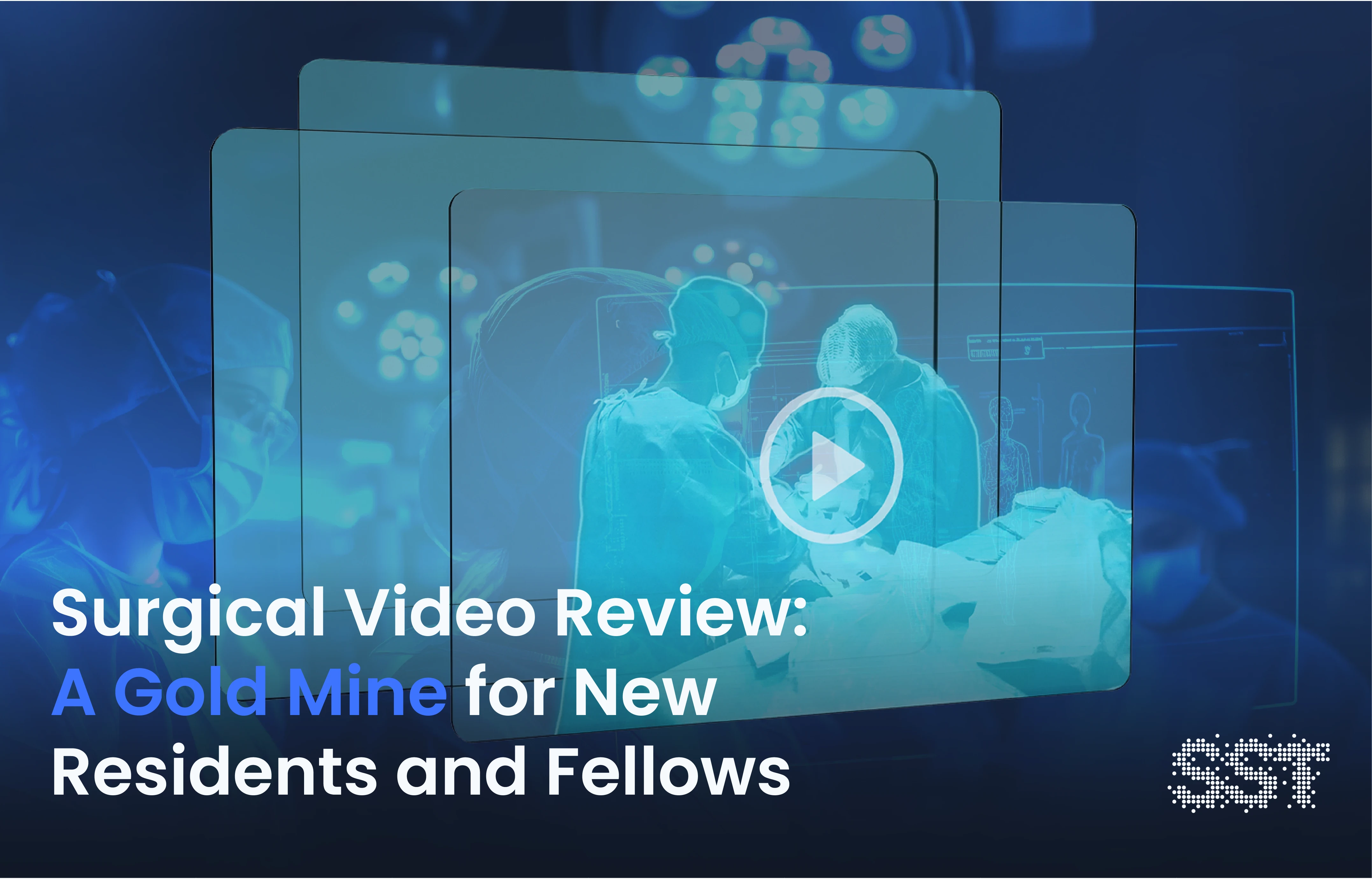TRAINING AND EDUCATION
Surgery Videos: Preparing Residents and Fellows for OR Autonomy
Surgical training is evolving rapidly, and cutting-edge technology is playing a pivotal role in reshaping how residents and fellows prepare for autonomy in the operating room.
Jan 9, 2025
Joshua Villarreal, MD
General Surgery Resident and Clinical Informatics Fellow
Surgical training is evolving rapidly, and cutting-edge technology is playing a pivotal role in reshaping how residents and fellows prepare for autonomy in the operating room. Surgery videos are at the forefront of this transformation, offering an unparalleled learning experience with detailed insights into surgical techniques, enhanced case preparation, and opportunities for skill collaboration. This post explores the power of surgery videos to revolutionize surgical education by providing standardized training, augmented debriefs, and comprehensive preparation for even the most complex cases.
Introduction
Surgical training has long been characterized by an apprenticeship model—watching, assisting, and gradually gaining autonomy under the watchful eye of experienced attendings. However, emerging technologies are transforming this landscape, offering unprecedented opportunities for medical training and skill development.¹
With OR Black Box® technology,² we can now efficiently review complex operations frame by frame, simultaneously analyze multiple surgery video feeds, and delve into the nuanced techniques of experienced surgeons—offering unparalleled depth and clarity to better prepare for future challenging cases.
At the forefront of this surgical data science revolution are advanced surgery video review tools³ that are redefining how the next generation of surgeons prepare, learn, and excel. This innovative technology goes far beyond simply recording procedures – they are powerful educational tools that provide granular insights, facilitate detailed coaching and performance analysis,⁴ and create a new paradigm of surgical skill acquisition.
Enhanced Trainee Case Preparation
A common challenge among surgical trainees is the lack of standardization in case preparation preferences across surgeons. A clear understanding of the attending surgeon’s positioning and instrument specifications is a prerequisite for residents and fellows to progressively increase autonomy in the operating room. While some residency programs have made efforts to codify these preferences for future trainees, they are often limited to summary lists or spreadsheets.
Surgery videos can greatly expedite the path to graduated autonomy by providing access to indexed surgery video clips in advance, affording detailed insight into:
Patient positioning
Precise retractor placement and usage
Critical procedure steps and nuanced technical approaches
Instrument selection and management
This level of detail allows residents to review critical aspects of an operation before scrubbing in, dramatically enhancing preparedness and optimizing learning opportunities. The visual, context-rich preparation materials bridge the gap between theoretical knowledge and practical application in the OR.
Standardized Technique Training
Surgery videos offer more than just case-specific preparation—they provide a mechanism for standardizing surgical techniques across training programs. These platforms create a rich, dynamic library of best practices by capturing and cataloging procedures from multiple experienced surgeons.
Residents and fellows can now:
Review multiple approaches to the same procedure
Identify subtle variations in technique
Learn from a diverse range of surgical approaches
Develop a more comprehensive understanding of procedural nuances
Review their own surgical performance and identify areas for improvement
Augmented Operative Debriefs
The operative debrief⁵ offers a valuable learning opportunity for trainees, providing insights into key events, areas for improvement, and aspects of the procedure that may have been overlooked and require further exploration. Incorporating a process to review surgery videos into a structured educational curriculum can significantly enhance these debrief sessions by:
Allowing precise, frame-by-frame analysis of critical moments
Providing objective visual documentation of performance
Facilitating more targeted and constructive feedback
Helping trainees self-identify areas for improvement
Enhanced Preparation for Complex or Rare Procedures
Surgical training presents a unique challenge when it comes to complex or rare procedures. These specialized interventions often occur infrequently, making comprehensive preparation particularly critical. Surgery videos have emerged as a game-changing solution to this long-standing educational dilemma.
Surgery video libraries offer an unprecedented opportunity for in-depth preparation for procedures that a resident or fellow might encounter only a handful of times during their entire training. These tools allow trainees to:
Simulate rare procedural scenarios through comprehensive video documentation
Analyze multiple approaches to challenging surgical interventions
Break down intricate steps of complex surgeries in meticulous detail
Access a platform for discussion of surgical techniques and shared understanding
Developmental muscle memory through repeated virtual review
Reduced Learning Curve for New Tools and Techniques
Surgical innovation moves quickly, with new tools and techniques constantly emerging. Surgery videos serve as an accelerant for learning these advancements, offering:
Detailed demonstrations of new surgical instruments and innovations
Comparative analyses of traditional vs. innovative approaches
A mechanism for rapidly disseminating cutting-edge surgical knowledge
Global collaboration and knowledge sharing
The potential for global collaboration through surgery videos is immense. They are helping to create a world where surgical expertise is not confined by geographical boundaries—where a provider in a small community hospital or a developing country⁶ can learn from a world-renowned surgeon's technique, all through the power of video review.
Conclusion
We are witnessing a fundamental transformation in surgical education as we continue to embrace these technological advancements. The future of surgical training will bring comprehensive, technology-enabled skill development that prioritizes patient safety, surgical excellence, and continuous improvement. Residents and fellows embarking on their surgical journey will experience these surgery video tools as gateways to mastery, offering unprecedented insights and opportunities for growth.
Explore how surgery videos can reshape your approach to learning and prepare you—and the next generation—for exceptional performance in the OR. Don’t miss the chance to experience the full benefits of this game-changing educational tool!
Looking to learn more about surgical education? Discover additional insights here.²
Recommended Reading
Bai, N. (2022). ‘Black boxes’ in Stanford Hospital operating rooms aid training and safety. Stanford Medicine News Center. https://med.stanford.edu/news/all-news/2022/09/black-box-surgery.html. Accessed December 18, 2024.
OR Black Box - SST. (2024). Surgicalsafety.com. https://www.surgicalsafety.com/solutions/or-black-box. Accessed December 18, 2024.
Explorer - SST. Surgical Safety Technologies. https://www.surgicalsafety.com/solutions/or-black-box/explorer. Accessed December 18, 2024.
Bonrath, E.M., Dedy, N.J., Gordon, L.E., & Grantcharov, T.P. (2015). Comprehensive Surgical Coaching Enhances Surgical Skill in the Operating Room: A Randomized Controlled Trial. Ann Surg;262(2):205-12. https://www.doi.org/10.1097/SLA.0000000000001214.
Campbell, K.K., Abreu, A.A., Zeh, H.J., et., al. (2024). Using OR Black Box Technology to Determine Quality Improvement Outcomes for In-situ Timeout and Debrief Simulation. Annals of Surgery. https://www.doi.org/10.1097/SLA.0000000000006438.
Surgical Safety Technologies Expands Partnership with Wellcome Leap to Improve Surgical Outcomes Across the Globe. (2024). Surgical Safety Technologies. https://www.surgicalsafety.com/company/news/surgical-safety-technologies-expands-partnership-with-wellcome-leap-to-improve-surgical-outcomes-across-the-globe. Accessed December 18, 2024.






